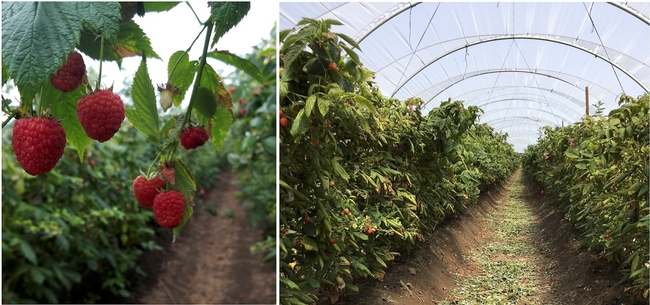Department of Microbiology and Plant Pathology, UC Riverside
Raspberry (Rubus spp.) is an important crop for California, where it is among the top 20 commodities with an average annual value of $448 million from 2015 to 2017 (CDFA: California Agricultural Statistics Review 2017-2018). This represented 82% to 88% of the domestic raspberry production. The four California counties where raspberry is produced are Ventura, Santa Cruz, Santa Barbara, and Monterey. Specifically in Ventura and Santa Cruz counties, raspberries are among the top commodities (California Agricultural Statistics Review 2017-2018). On the West Coast of the United States, raspberry is typically produced in two stages from a single planting that is grown for a maximum of two years. In the primocane stage or first year cycle, harvest generally begins five months after planting of bare root transplants and continues for approximately three months. After harvest, the primocane growth is pruned near the last fruiting lateral or is mown at the soil line. The growth that follows this pruning begins the floricane stage or second cycle, which has a harvest period that generally begins three months after pruning and can last approximately two months (personal communication Jose Gomez, Driscolls). Fresh market raspberry production in Ventura County is commonly grown on 3 rows of densely-planted raspberries under one plastic hoop tunnel (Figure 1). Raspberries are grown under protected structures, plastic covered high-hoop tunnels to extend the production season and to protect the delicate fruit from direct sun or rain/fog damage. In Ventura County, a crop can be planted during four periods throughout the year: early spring, late spring, mid-summer, or late summer. Main production challenges include limited availability of farm workers, Phytophthora root rot, Yellow rust, Botrytis fruit rot, Spotted wing drosophila, and Two-spotted spider mites (UC IPM online). In 2018, the raspberry industry in Ventura County produced 64,736 tons on a little over 4,000 acres (Ventura County's 2018 Crop and Livestock Report).
Figure. Standardraspberry planting under one plastic hoop tunnel.
Useful Link: UC IPM Online: http://ipm.ucanr.edu/PMG/selectnewpest.caneberry.html - UC IPM Pest Management Guidelines: Caneberries. Production Cost Study online: https://coststudyfiles.ucdavis.edu/uploads/cs_public/20/e3/20e339eb-2ea7-41f0-8823-26939ff07c06/bpraspberry-cc-finaldraft.pdf
